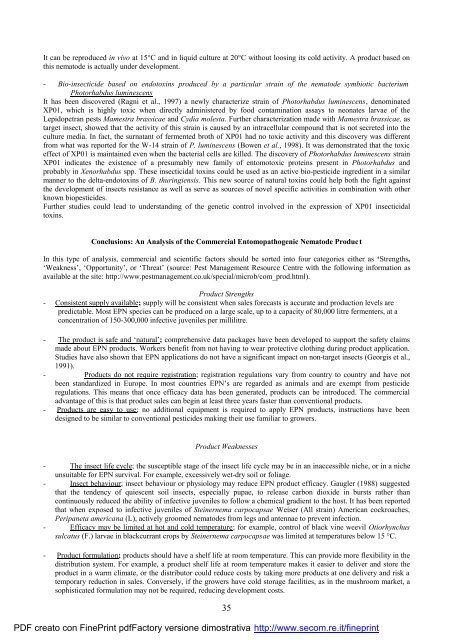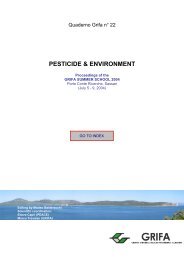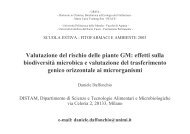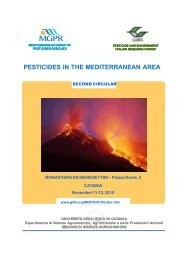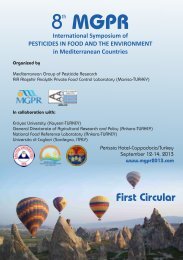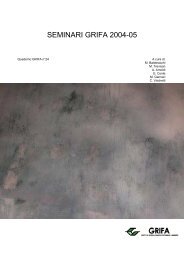International Congress BIOLOGICAL PRODUCTS - Gruppo di ...
International Congress BIOLOGICAL PRODUCTS - Gruppo di ...
International Congress BIOLOGICAL PRODUCTS - Gruppo di ...
You also want an ePaper? Increase the reach of your titles
YUMPU automatically turns print PDFs into web optimized ePapers that Google loves.
It can be reproduced in vivo at 15°C and in liquid culture at 20°C without loosing its cold activity. A product based on<br />
this nematode is actually under development.<br />
- Bio-insecticide based on endotoxins produced by a particular strain of the nematode symbiotic bacterium<br />
Photorhabdus luminescens<br />
It has been <strong>di</strong>scovered (Ragni et al., 1997) a newly characterize strain of Photorhabdus luminescens, denominated<br />
XP01, which is highly toxic when <strong>di</strong>rectly administered by food contamination assays to neonates larvae of the<br />
Lepidopetran pests Mamestra brassicae and Cy<strong>di</strong>a molesta. Further characterization made with Mamestra brassicae, as<br />
target insect, showed that the activity of this strain is caused by an intracellular compound that is not secreted into the<br />
culture me<strong>di</strong>a. In fact, the surnatant of fermented broth of XP01 had no toxic activity and this <strong>di</strong>scovery was <strong>di</strong>fferent<br />
from what was reported for the W-14 strain of P. luminescens (Bowen et al., 1998). It was demonstrated that the toxic<br />
effect of XP01 is maintained even when the bacterial cells are killed. The <strong>di</strong>scovery of Photorhabdus luminescens strain<br />
XP01 in<strong>di</strong>cates the existence of a presumably new family of entomotoxic proteins present in Photorhabdus and<br />
probably in Xenorhabdus spp. These insecticidal toxins could be used as an active bio-pesticide ingre<strong>di</strong>ent in a similar<br />
manner to the delta-endotoxins of B. thuringiensis. This new source of natural toxins could help both the fight against<br />
the development of insects resistance as well as serve as sources of novel specific activities in combination with other<br />
known biopesticides.<br />
Further stu<strong>di</strong>es could lead to understan<strong>di</strong>ng of the genetic control involved in the expression of XP01 insecticidal<br />
toxins.<br />
Conclusions: An Analysis of the Commercial Entomopathogenic Nematode Product<br />
In this type of analysis, commercial and scientific factors should be sorted into four categories either as ‘Strengths,<br />
‘Weakness’, ‘Opportunity’, or ‘Threat’ (source: Pest Management Resource Centre with the following information as<br />
available at the site: http://www.pestmanagement.co.uk/special/microb/com_prod.html).<br />
Product Strengths<br />
- Consistent supply available; supply will be consistent when sales forecasts is accurate and production levels are<br />
pre<strong>di</strong>ctable. Most EPN species can be produced on a large scale, up to a capacity of 80,000 litre fermenters, at a<br />
concentration of 150-300,000 infective juveniles per millilitre.<br />
- The product is safe and ‘natural’; comprehensive data packages have been developed to support the safety claims<br />
made about EPN products. Workers benefit from not having to wear protective clothing during product application.<br />
Stu<strong>di</strong>es have also shown that EPN applications do not have a significant impact on non-target insects (Georgis et al.,<br />
1991).<br />
- Products do not require registration; registration regulations vary from country to country and have not<br />
been standar<strong>di</strong>zed in Europe. In most countries EPN’s are regarded as animals and are exempt from pesticide<br />
regulations. This means that once efficacy data has been generated, products can be introduced. The commercial<br />
advantage of this is that product sales can begin at least three years faster than conventional products.<br />
- Products are easy to use; no ad<strong>di</strong>tional equipment is required to apply EPN products, instructions have been<br />
designed to be similar to conventional pesticides making their use familiar to growers.<br />
Product Weaknesses<br />
- The insect life cycle; the susceptible stage of the insect life cycle may be in an inaccessible niche, or in a niche<br />
unsuitable for EPN survival. For example, excessively wet-dry soil or foliage.<br />
- Insect behaviour; insect behaviour or physiology may reduce EPN product efficacy. Gaugler (1988) suggested<br />
that the tendency of quiescent soil insects, especially pupae, to release carbon <strong>di</strong>oxide in bursts rather than<br />
continuously reduced the ability of infective juveniles to follow a chemical gra<strong>di</strong>ent to the host. It has been reported<br />
that when exposed to infective juveniles of Steinernema carpocapsae Weiser (All strain) American cockroaches,<br />
Peripaneta americana (L), actively groomed nematodes from legs and antennae to prevent infection.<br />
- Efficacy may be limited at hot and cold temperature; for example, control of black vine weevil Otiorhynchus<br />
sulcatus (F.) larvae in blackcurrant crops by Steinernema carpocapsae was limited at temperatures below 15 °C.<br />
- Product formulation; products should have a shelf life at room temperature. This can provide more flexibility in the<br />
<strong>di</strong>stribution system. For example, a product shelf life at room temperature makes it easier to deliver and store the<br />
product in a warm climate, or the <strong>di</strong>stributor could reduce costs by taking more products at one delivery and risk a<br />
temporary reduction in sales. Conversely, if the growers have cold storage facilities, as in the mushroom market, a<br />
sophisticated formulation may not be required, reducing development costs.<br />
PDF creato con FinePrint pdfFactory versione <strong>di</strong>mostrativa http://www.secom.re.it/fineprint<br />
35


